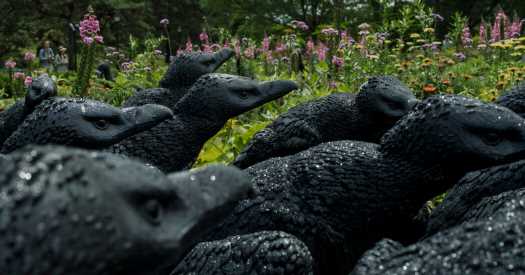I have to admit, I didn’t notice them at first. They blend seamlessly as shadows into the bright red petunias and purple coleus on the lawn of the New York Botanical Garden’s Enid A. Haupt Conservatory. Only when I stooped to read the label for one velvety red blossom — it was a cockscomb, Celosia “Dracula” — did I notice the knee-high, cast-foam black vulture that was sitting watchfully beside it. When I looked up, I realized there were dozens more. The gardens were full of them.
They were installed by the Jamaican-born mixed media artist Ebony G. Patterson for her show, “ … things come to thrive … in the shedding … in the molting.” The culmination of her intermittent but yearslong residency at the Garden and its library, the exhibition also includes work installed across several floors of the Garden’s library — but it’s the vultures that cut the deepest.
They come in four varieties — standing, turning, browsing and jutting forward — and what a strict accounting would call several different colors.
They all read as more or less black, particularly when viewed in groups. But layers of glitter, whitish stains and their exact siting amid the floral light and shadow give each a subtly different chromatic effect. Some could pass for charcoal gray, one has a gaudy, unmistakably purple back. At the same time they remain variations on a type, gracefully lending substance and depth to the flowers they stand among, even as they constitute their own separate world.
Patterson, 42, who lives and works between Kingston, Jamaica, and Chicago, has taught and exhibited widely in the United States. In the wall labels and exhibition materials, she raises the idea of gardens generally as places of healing and regeneration — but also as sites marked by the legacies of slavery and colonialism, both in the plants that have been removed from their native habitats and in the labor associated with them. She also talks about vultures as caretakers, indispensable parts of a natural world that includes death, decay and extinction. (We don’t often think about scavengers, but once we’re primed to notice them, they’re everywhere.)
Outside the Conservatory, all these ideas make for a startling sense of expansiveness. Whether standing alone or in bustling groups of up to 30, as though engaged in contentious debate, the vultures seem to inhabit spaces you wouldn’t have noticed. They draw your own gaze down, too, forcing you to consider the flower beds not just as careful symphonies of shape and color but as riotous crowds of individuals.
Inside the Conservatory, where Patterson has also installed cast-glass leaves and body parts, the mood turns chillier. Dismembered feet sticking out over potted petunias evoke slavery and colonial violence. Ghostly white plant forms modeled on extinct species might refer to race, or to climate catastrophe, or to the insatiable emptiness of our information age.
However you read the details, though, the triumph of the piece is the way that Patterson’s art enhances the botanical exhibits. A display of petunias and begonias such as you might buy at Home Depot — the kind of tropical plants made available in New York by cargo planes and capitalism — gains historical context, or moral grounding, from the addition of Patterson’s lost species and glass feet. You’re forced to think about the larger forces that make botanical gardens possible. But the addition of colors and textures also makes the flowers even prettier. (As Patterson herself put it in her remarks at the show’s opening, “Even in the ugliness, beauty is possible.”)
Patterson’s low-key but thoughtful approach to the resources of the institution continues in the LuEsther T. Mertz Library. A three-channel video portrait of a primordial garden and intricate paper collages alternate with an historical exhibition from the collection on extinction, including a number of dried specimens. Next to Patterson’s installations and collages, the historical material can’t help looking colorless. But that only adds a compelling undertone of tragedy.
On the top floor stands the strongest single piece in the library, “ … fester…,” a free-standing 10-foot wall covered on one side by thick folds of tapestry studded with tassels, beads, more glass plant forms and a line of gilded plastic vertebrae, and on the other with hundreds of red gloves. In combination with tropical patterned wallpaper and vultures perching by the ceiling, “ … fester … ” alludes to luxury and decay, excess and constraint, beauty and ugliness, but majestically refuses to pin any of it down.
That said, it doesn’t seem quite right to parse the show’s pieces one by one; it’s as a total installation — Patterson’s complex but singular response to the New York Botanical Garden as she found it — that it’s most successful.
… things come to thrive … in the shedding … in the molting …
Through Sept. 17, New York Botanical Garden, 2900 Southern Boulevard, Bronx, N.Y., 718-817-8700; nybg.org.
Will Heinrich writes about new developments in contemporary art, and has previously been a critic for The New Yorker and The New York Observer. @willvheinrich
Source: Read Full Article
